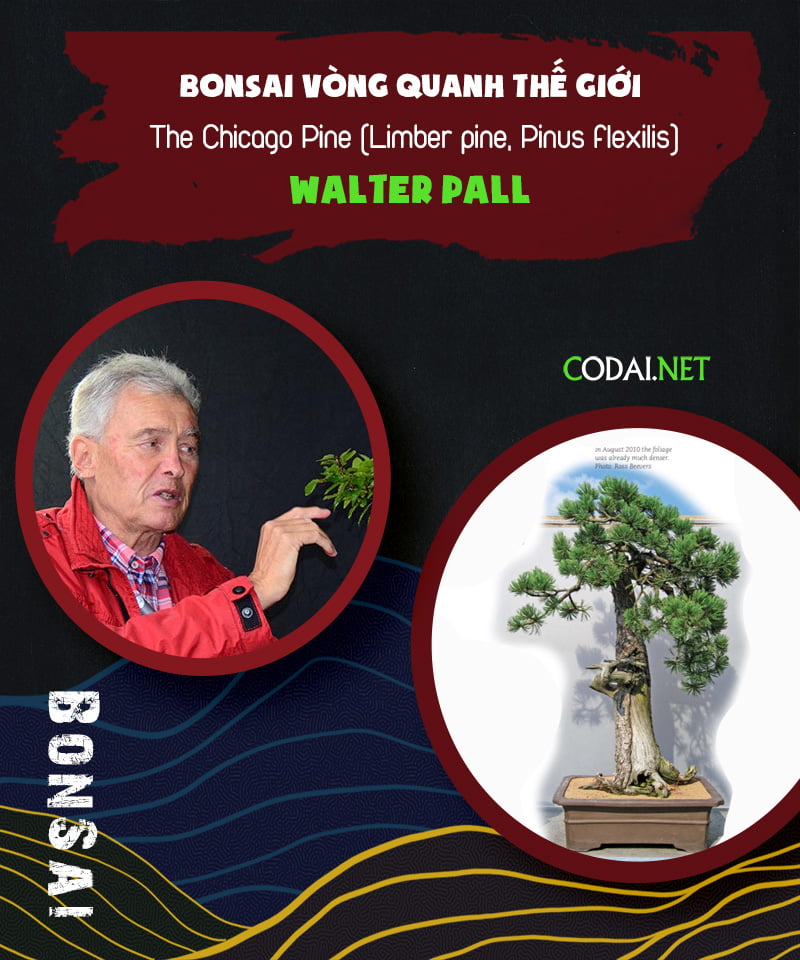Bonsai, Bonsai Focus Magazine, Chia sẻ kinh nghiệm, Người nổi tiếng
Bậc thầy Bonsai Walter Pall làm việc trên cây Bonsai quý giá nhất của Chicago: The Chicago Pine (Limber pine, Pinus flexilis)
Nguồn: Tạp chí Bonsai Focus English Edition T9/T10 2016
Dịch và biên tập: Dũng Cá Xinh (15/08/2021)
English
The Chicago Pine: Walter Pall works on Chicago’s most precious bonsai
- Text: Walter Pall Photography: Walter Pall, Aaron Burke
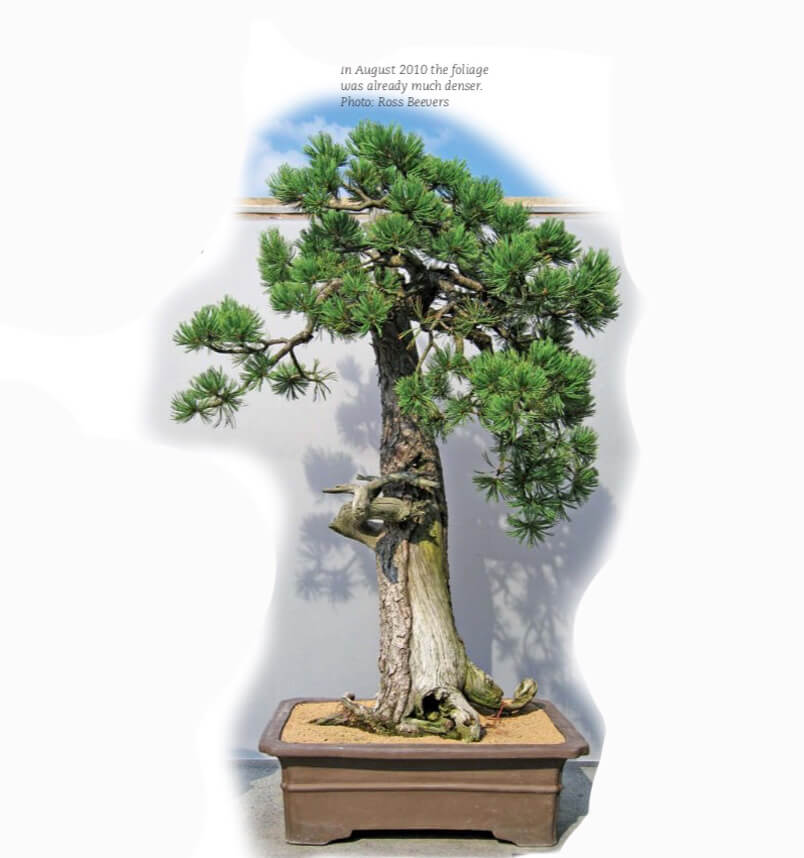
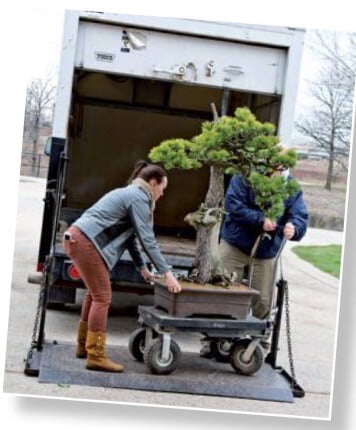
Walter Pall has performed on many aninternational stage and is probably one of the world’s most popular bonsai artists. His lectures are a treat. He adds a substantial amount of explanation so that the audience can clearly understand his development process and he tells amusing anecdotes along the way. He was invited by the Chicago Botanic Garden to come and do a demonstration on what is one of their oldest and most precious trees.
In the early 1980s Harold Sazaki had the opportunity of collecting a Limber pine (Pinus flexilis) in Estes Park, Colorado, at an elevation of about 10,000 feet. The age of the tree may be estimated between 500 and 1,000 years old. Gerald Weiner had previously acquired the pine after its collection and donated it to the bonsai collection of the Chicago Botanic Garden in 2007.
Landscape tree
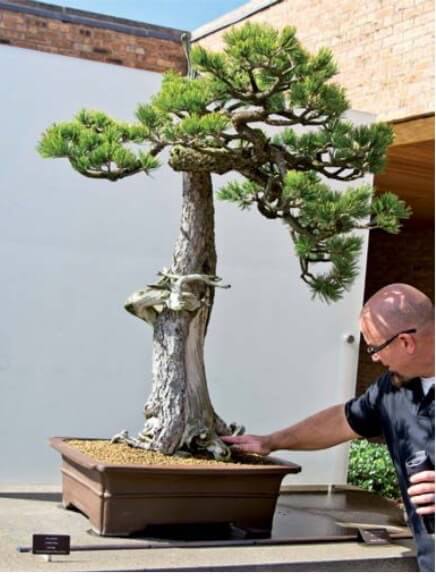
On its arrival at the Botanic Garden this spectacular tree was clearly extremely challenging as bonsai. It was probably collected to be used as a landscape tree. While healthy, it was obviously too big, seemed enormous and clearly too tall and stiff. At that time it didn’t really offer to become a regular bonsai, with branches all at the very top and great deadwood, but without an obvious front. In 2007 Colin Lewis had the honour to be the first to style this great pine. It is unfortunate that there are no documents of this initial styling. However, Colin apparently did a great job to start the bonsai career of this tree. It is quite normal though that, many years after the first styling, a major remake takes place.
A long conversation
Through the notable efforts of Susumu Nakamura and Ivan Watters as well as current Chicago Botanic Garden Curator, Chris Baker the tree was maintained. During a 2014 visit to the Garden, a long conversation with Chris took place in which we discussed many of the trees displayed in the current collection. The limber pine on display stood out as a tree that would possibly benefit from some changes to bring out its full quality. To my surprise and delight the Botanic Garden commissioned me to do exactly that in 2016.
The aim should be to create the feeling of an ancient tree that stands on the edge of a cliff
Old and powerful
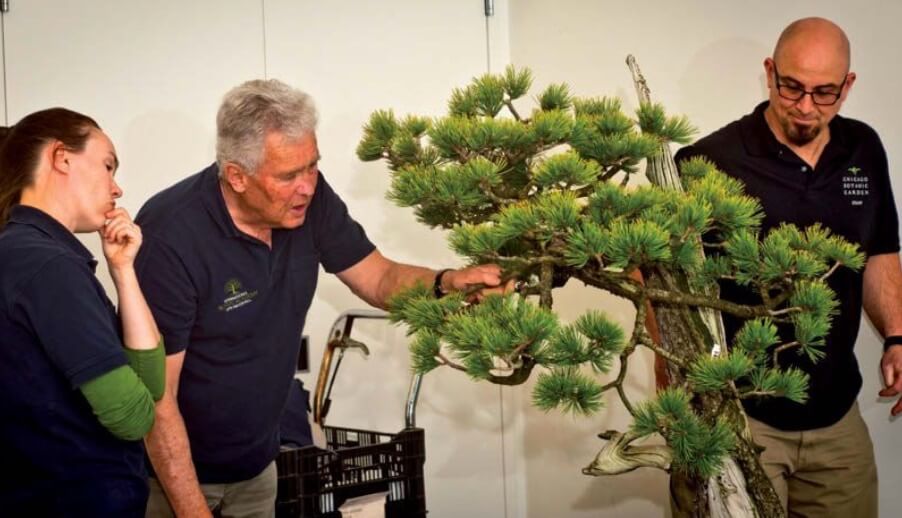
The tree appeared great, old and powerful while also a bit raw and untamed. Further it seemed too big, too tall, too massive even for a large exhibition area. Branches looked natural, but untamed. The crown at the top was too dense and hid the great deadwood along the trunk, thereby not allowing the viewer to see the structure of the branches. One portion of the trunk appeared at an abrupt unsightly right angle. Additional challenges included the appearance of almost no movement in the trunk line and a crown that seemed too wide, dense and with little direction.
As a first approach the most important improvement would be to tilt the trunk to the right (seen from the original front) creating movement and reducing the stiff, straight look. At the same time making the crown much smaller and compact by cutting off the left part totally, creating a dramatic dropping branch on the right. This would reduce the optical weight of the crown and at the same time give a clear direction and movement. By making these changes the canopy no longer gives the impression of being too balanced and eliminates overall heaviness. And by cutting out some branches on top and plucking foliage overall the optical weight would be reduced further, pointing the viewer’s eye to the trunk rather than the crown
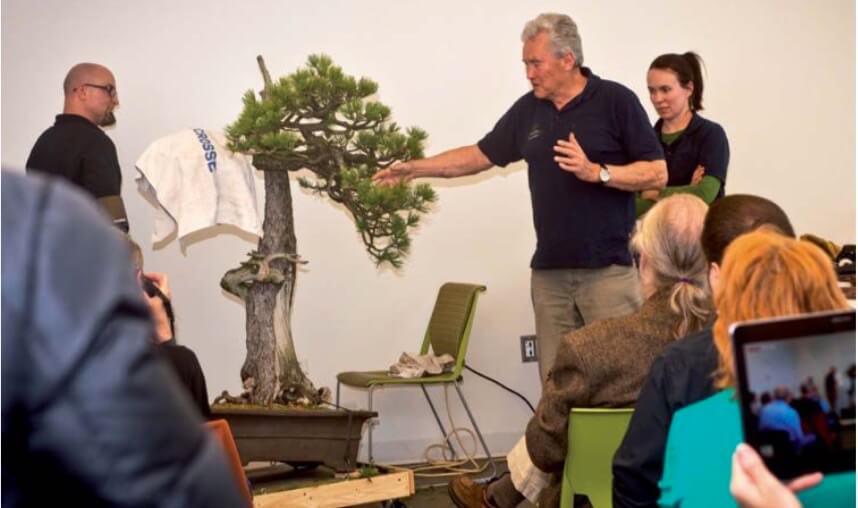
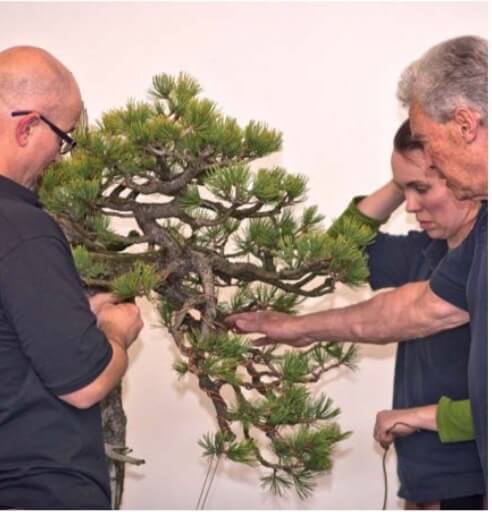
A demonstration
In April 2016 a public demonstration took place at Chicago Botanic Garden where the tree’s new transformation began. Chris Baker, curator of the collection and Jennifer Price, the assistant of Walter Pall, were ready for the big event. Transport of this monster tree had to be planned well. It was decided not to do any really drastic applications as they would endanger the tree and they were not necessary.
The three of us had a clear plan for the work, but we discussed this again for the public’s benefit. First the crew pinched the old needles. In Japan plucking needles is done in October, but really pinching is possible from end of summer until the end of the following April. After the tree is plucked it already looked much better. Simply by taking off about 50 % of the green the optical weight of the crown was reduced considerably and the tree looked mightier, but no longer too big. Next the removal of the left part of the crown was considered. Several possible fronts were discussed, but it was decided to work around the tree making it a 360-degree bonsai. The pine was then tilted to the right looking at it from the original front. Instantly it appeared more alive, not so stiff — even elegant.
Vertical position
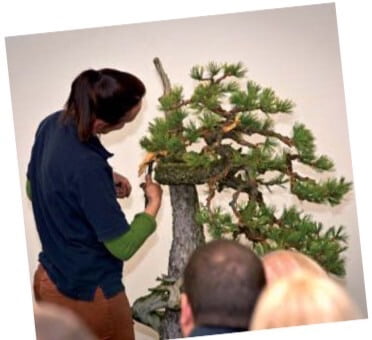
The rest was simply a lot of wiring by Chris and Jennifer. The main branch was pulled down into a near vertical position using guy wires. The foliage now began just slightly below the 50% of the height
line. Thus the pine looked less massive, but still very powerful. The intention was to make the tree look nicer, but certainly not too nice. The wildness of this old piece needed to be contained. We did not want to make a house swine of a wild boar, meaning that we absolutely wanted to avoid those standard almost plastic looking bonsai branches for this tree. This is absolutely not the plan. Typical bonsai branches would make this tree look much younger. There is no need for any more ramification than the tree already has, although the pads can grow denser. The age should be reflected in the branches and not only in the trunk. It is extremely important for the top to stay transparent in order to always see the structure of the crown.
A fixed front
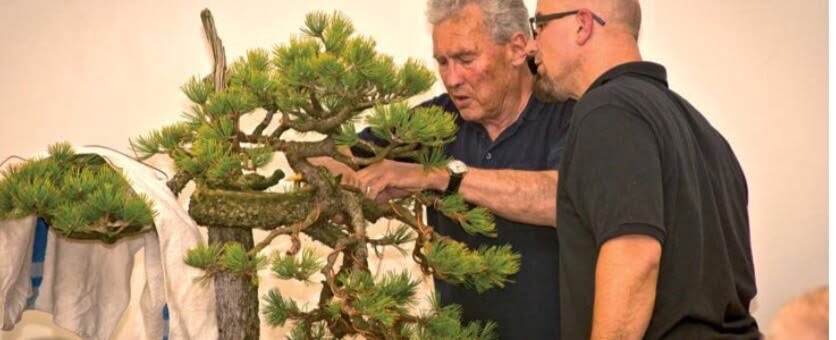
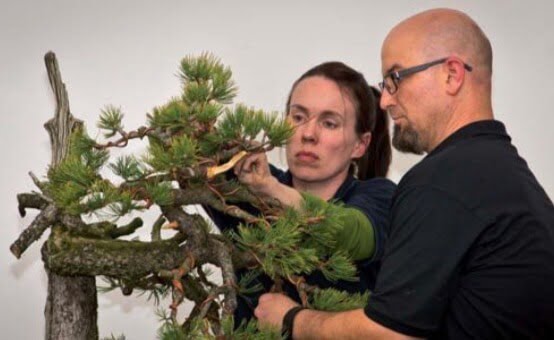
After the restyling it has become clear that the original front was only one of many good options. To work around the tree instead of towards a fixed front as we were taught opens many possibilities. A bonsai has a clear front a tree does not. At least three views of the pine now look very good. To have many excellent fronts and to find it difficult to choose which one to use is the kind of problem we want. Placing it so that the tree can be viewed from all sides is probably the best solution, thereby allowing the viewer and not the artist to decide.
Two virtual images show the possible choice for a new container. The most spectacular being able to mount the pine on a natural stone slab. This can happen in spring or autumn 2017. I look forward to, hopefully, being a part of this final move.
The Bonsai of the Chicago Botanic Garden
The Chicago Botanic Garden’s collection of nearly 200 bonsai includes gifts from the Midwest Bonsai Society and from Japanese bonsai Master, Susumu Nakamura. Among the trees donated by Nakamura was a Japanese white pine that has been trained for at least 100 years.
- 1000 Lake Cook Road
- Glencoe, IL 60022. USA. Info: www.chicagobotanic.org
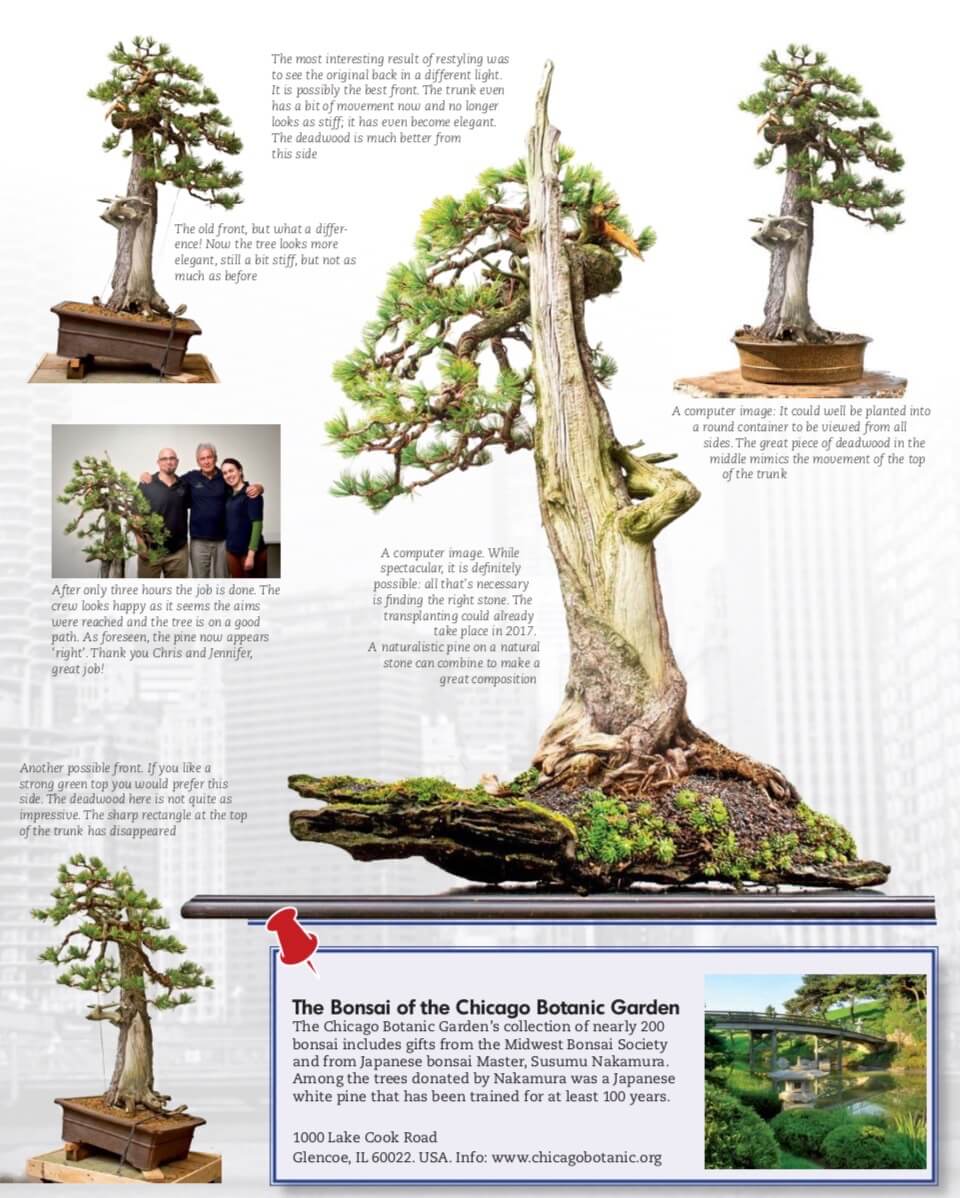
- The most interesting result of restyling was to see the original back in a different light. It is possibly the best front. The trunk even has a bit of movement now and no longer looks as stiff; it has even become elegant. The deadwood is much better from this side
- The old front, but what a difference! Now the tree looks more elegant, still a bit stiff, but not as much as before
- After only three hours the job is done. The crew looks happy as it seems the aims were reached and the tree is on a good path. As foreseen, the pine now appears ‘right’. Thank you Chris and Jennifer, great job!
- Another possible front. If you like a strong green top you would prefer this side. The deadwood here is not quite as impressive. The sharp rectangle at the top of the trunk has disappeared
- A computer image: It could well be planted into a round container to be viewed from all sides. The great piece of deadwood in the middle mimics the movement of the top of the trunk
- A computer image. While spectacular, it is definitely possible: all that’s necessary is finding the right stone. The transplanting could already take place in 2017. A naturalistic pine on a natural stone can combine to make a great composition
Tiếng Việt
- Bài viết: Walter Pall – Hình ảnh: Walter Pall, Aaron Burke


Walter Pall đã trình diễn trên nhiều sân khấu quốc tế và có lẽ là một trong những nghệ nhân Bonsai nổi tiếng nhất thế giới. Các bài giảng của ông ấy thường như một bữa tiệc. Ông ấy bổ sung một lượng lớn lời giải thích để khán giả có thể hiểu rõ ràng về quá trình phát triển cũng như Pall thường kể về những giai thoại thú vị trên đường đi. Ông đã được Vườn bách thảo Chicago mời đến và thực hiện một cuộc trình diễn trên một trong những cây cổ nhất và quý giá nhất của họ.
Vào đầu những năm 1980, Harold Sazaki có cơ hội thu thập một Cây Thông Limber (Pinus flexilis) ở Công viên Estes, Colorado, ở độ cao khoảng 10.000 feet (3,4 km). Tuổi của cây có thể được ước tính từ 500 đến 1.000 năm tuổi. Gerald Weiner sau đó đã mua lại cây thông để bổ sung vào bộ sưu tập cá nhân và rồi tặng nó cho bộ sưu tập cây cảnh của Vườn bách thảo Chicago vào năm 2007.
Cây cảnh quan

Khi đến Vườn Bách thảo, cái cây ngoạn mục này rõ ràng là cực kỳ thách thức để trở thành một cây Bonsai. Nó có lẽ đã được thu thập để sử dụng làm cây cảnh quan. Mặc dù rất khỏe mạnh, nó rõ ràng là quá to, khổng lồ và rõ ràng là quá cao và thô. Vào thời điểm đó, nó không thực sự trở thành một cây Bonsai thông thường, với các cành đều ở trên cùng và phần gỗ chết lớn, nhưng không có mặt tiền rõ ràng. Năm 2007 Colin Lewis vinh dự là người đầu tiên tạo kiểu cho cây thông vĩ đại này. Thật không may là không có tài liệu về kiểu dáng ban đầu. Tuy nhiên, Colin rõ ràng đã làm rất tốt khi bắt đầu hành trình Bonsai của loài cây này. Nhiều năm sau lần tạo kiểu đầu tiên, thường sẽ có những lần đại tu lớn khác.
Một cuộc hội thoại dài
Thông qua những nỗ lực đáng chú ý của Susumu Nakamura và Ivan Watters cũng như Người quản lý Vườn Bách thảo Chicago hiện tại, Chris Baker, cây đã được chăm sóc. Trong một chuyến thăm năm 2014 đến Khu vườn, một cuộc trò chuyện dài với Chris đã diễn ra, trong đó chúng tôi thảo luận về nhiều cây được trưng bày trong bộ sưu tập hiện tại. Cây thông Limber này được trưng bày nổi bật như một loại cây có thể được hưởng lợi từ một số thay đổi để phát huy hết chất lượng của nó. Trước sự ngạc nhiên và thích thú của tôi, Botanic Garden đã ủy quyền cho tôi làm chính xác điều đó vào năm 2016.
Mục đích là tạo ra cảm giác như một cái cây cổ thụ đứng trên rìa của một vách đá
Già cỗi và mạnh mẽ

Cây có vẻ to lớn, già cỗi và mạnh mẽ trong khi còn hơi thô và chưa được thuần hóa. Hơn nữa, nó dường như quá lớn, quá cao, quá đồ sộ ngay cả đối với một khu triển lãm lớn. Các nhánh trông tự nhiên, nhưng chưa được thuần hóa. Phần đỉnh quá dày đặc và che mất phần gỗ chết lớn dọc theo thân cây, do đó không cho phép người xem nhìn thấy cấu trúc của các cành cây. Một phần của thân cây đột ngột xuất hiện ở một góc vuông khó coi. Các thử thách bổ sung bao gồm thực tế không có chuyển động trong đường thân và một tàng cây (vương miện) dường như quá rộng, dày đặc và ít định hướng.
Theo cách tiếp cận đầu tiên, cải tiến quan trọng nhất sẽ là nghiêng chậu cây sang bên phải (nhìn từ mặt tiền ban đầu) tạo ra chuyển động và giảm vẻ cứng nhắc, thẳng thắn. Đồng thời, làm cho tàng cây nhỏ và gọn hơn nhiều bằng cách cắt bỏ hoàn toàn phần bên trái, tạo ra một nhánh rơi ấn tượng ở bên phải. Điều này sẽ làm giảm trọng lượng quang học của vương miện và đồng thời cung cấp một hướng và chuyển động rõ ràng. Bằng cách thực hiện những thay đổi này, tán cây không còn tạo cảm giác quá cân đối và loại bỏ sự nặng nề tổng thể. Và bằng cách cắt bỏ một số cành trên đỉnh và cắt tỉa bớt lá, trọng lượng quang học sẽ giảm hơn nữa, hướng mắt người xem vào thân cây hơn là tàng cây


Một buổi trình diễn
Vào tháng 4 năm 2016, một cuộc trình diễn công khai đã diễn ra tại Vườn bách thảo Chicago, nơi bắt đầu quá trình chuyển đổi mới của cây. Chris Baker, người phụ trách bộ sưu tập và Jennifer Price, trợ lý của Walter Pall, đã sẵn sàng cho sự kiện lớn. Việc vận chuyển cây quái vật này phải được lên kế hoạch tốt. Nó đã được quyết định không thực hiện bất kỳ hành động thực sự quyết liệt nào vì chúng sẽ gây nguy hiểm cho cây cũng không cần thiết.
Ba người chúng tôi đã có một kế hoạch rõ ràng cho công việc, nhưng chúng tôi đã thảo luận lại điều này vì lợi ích của công chúng. Đầu tiên, nhóm tỉa thưa những chiếc lá kim cũ. Ở Nhật Bản tuốt kim được thực hiện vào tháng 10, nhưng thực sự thì việc tuốt kim có thể kéo dài từ cuối mùa hè đến cuối tháng 4 năm sau. Sau khi cây được tỉa thưa, nó đã trông đẹp hơn nhiều. Chỉ đơn giản bằng cách loại bỏ khoảng 50% màu xanh lá cây, trọng lượng quang học của tán đã giảm đi đáng kể và cây trông mạnh mẽ hơn, nhưng không còn quá lớn. Tiếp theo, việc loại bỏ phần bên trái của vương miện đã được xem xét. Một số mặt tiền có thể đã được thảo luận, nhưng mọi người đã quyết định nghiên cứu xung quanh cái cây để biến nó thành một cây cảnh 360 độ. Cây thông sau đó đã được nghiêng sang bên phải khi nhìn vào nó từ mặt tiền ban đầu. Ngay lập tức nó trông sống động hơn, không quá cứng – thậm chí còn rất thanh lịch.
Vị trí dọc

Phần còn lại chỉ đơn giản là đi rất nhiều dây bởi Chris và Jennifer. Cành chính được kéo xuống vị trí gần như thẳng đứng bằng dây kẽm. Tán lá bây giờ chỉ bắt đầu thấp hơn 50% chiều cao một chút. Vì vậy, cây thông trông ít đồ sộ hơn, nhưng vẫn rất mạnh mẽ. Mục đích là làm cho cái cây trông đẹp hơn, nhưng chắc chắn là không quá đẹp. Sự hoang dã của tác phẩm cũ này cần phải được kiềm chế. Chúng tôi không muốn làm một ngôi nhà của một con lợn rừng, có nghĩa là chúng tôi hoàn toàn muốn tránh những cành cây Bonsai trông gần như hình dáng tiêu chuẩn. Đây hoàn toàn không phải là kế hoạch. Những cành cây Bonsai điển hình sẽ làm cho cây này trông trẻ hơn nhiều. Không cần phân nhánh nhiều hơn cây đã có, mặc dù các tán lá có thể phát triển dày đặc hơn. Tuổi cây nên được phản ánh trong các cành cây chứ không chỉ trong thân cây. Điều cực kỳ quan trọng là đỉnh phải trong suốt để luôn nhìn thấy cấu trúc của tàng cây.
Mặt tiền cố định


Sau khi tạo dáng lại, rõ ràng là mặt tiền ban đầu chỉ là một trong nhiều lựa chọn tốt. Làm việc xung quanh cái cây thay vì hướng về mặt tiền cố định như chúng ta đã được dạy sẽ mở ra nhiều khả năng. Cây Bonsai có mặt trước rõ ràng còn cây thông thường thì không. Ít nhất ba khung cảnh của cây thông bây giờ trông rất đẹp. Để có nhiều mặt trước xuất sắc và khó chọn cái nào để sử dụng là một vấn đề chúng tôi muốn. Đặt nó để cây có thể được nhìn từ mọi phía có lẽ là giải pháp tốt nhất, từ đó cho phép người xem chứ không phải nghệ sĩ quyết định.
Hai hình ảnh đồ hoạ hiển thị sự lựa chọn khả thi cho một chậu cây mới. Hoành tráng nhất là có thể gắn cây thông trên phiến đá tự nhiên. Điều này có thể được thực hiện vào mùa xuân hoặc mùa thu năm 2017. Tôi mong đợi, hy vọng, sẽ là một phần của động thái cuối cùng này.
Cây Bonsai của Chicago Botanic Garden
Bộ sưu tập gần 200 cây cảnh của Vườn bách thảo Chicago bao gồm quà tặng từ Hiệp hội Bonsai Trung Tây và từ Bậc thầy cây cảnh Nhật Bản, Susumu Nakamura. Trong số những cây do Nakamura tặng có một Cây thông trắng Nhật Bản (Japanese white pine) đã được đào tạo ít nhất 100 năm.
- 1000 Lake Cook Road
- Glencoe, IL 60022. USA. Info: www.chicagobotanic.org

- Kết quả thú vị nhất của việc tạo dáng lại là nhìn thấy phiên bản gốc trở lại dưới một ánh sáng khác. Nó có thể là mặt tiền tốt nhất. Thân cây thậm chí có một chút chuyển động bây giờ và không còn trông cứng nữa; nó thậm chí đã trở nên thanh lịch. Phần gỗ chết ở phía này tốt hơn nhiều
- Mặt tiền cũ, nhưng có điểm khác biệt! Bây giờ cây trông thanh thoát hơn, vẫn còn hơi cứng nhưng không nhiều như trước
- Chỉ sau ba giờ công việc đã hoàn thành. Nhóm trông rất vui vì có vẻ như các mục tiêu đã đạt được và cây đang bắt đầu một hành trình tốt. Như đã thấy trước, cây Thông bây giờ có vẻ ‘CHUẨN’. Cảm ơn Chris và Jennifer, rất tốt!
- Một mặt tiền khả dĩ khác. Nếu bạn thích một màu xanh lá cây mạnh mẽ, bạn sẽ thích mặt này hơn. Gỗ chết ở đây không hoàn toàn ấn tượng. Hình chữ nhật sắc nét ở đầu thân cây đã biến mất
- Hình ảnh máy tính: Nó có thể được trồng vào một chậu tròn để có thể xem từ mọi phía. Mảnh gỗ chết lớn ở giữa bắt chước chuyển động của đỉnh thân cây
- Một hình ảnh máy tính, mặc dù ngoạn mục nhưng chắc chắn là có thể xảy ra: Tất cả những gì cần thiết là tìm được loại đá phù hợp. Việc cấy ghép có thể đã diễn ra vào năm 2017. Một cây thông tự nhiên trên đá tự nhiên có thể kết hợp để tạo thành một bố cục tuyệt vời
